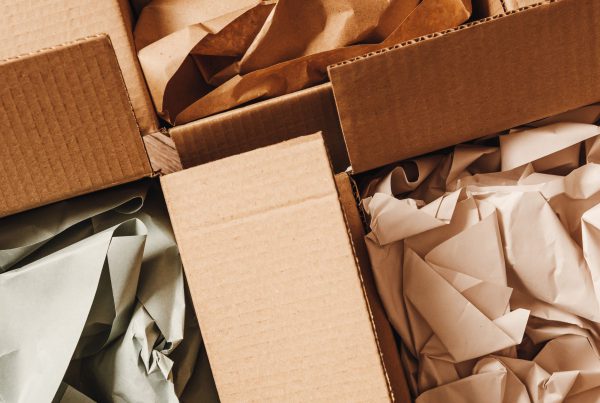Ever wondered why picking the correct shipping box sizes matters so much? The size of a shipping box can be the difference between your package arriving safe and sound or showing up damaged. Let’s dive into the world of standard shipping box sizes—crucial for anyone sending out goods, whether you’re a small business owner or just mailing a gift. Knowing the dimensions of shipping box options helps you choose the perfect fit, keeping your items secure and ensuring a smooth shipping process.
So, how does picking the correct box size impact your shipping and keep your customers smiling? Let’s find out.
Key Takeaways
- Choosing the correct shipping box sizes is vital for product safety.
- Understanding the dimensions of the shipping box can boost shipping efficiency.
- Standard shipping box sizes are critical in e-commerce logistics.
- Standard shipping boxes are designed for specific product types.
- The impact of box size on shipping costs can’t be overlooked.
Introduction to Shipping Box Sizes
Welcome to the world of shipping box sizes! Getting a handle on the different sizes available can make your shipping life significantly easier. From tiny boxes to massive ones like boxes 30x30x30, there’s a box for every product. This variety allows you to select the best fit for your items, ensuring they remain safe during transit.
Choosing the right box size isn’t just about tossing stuff in and hoping for the best. You need to consider the type, weight, and distance of your product’s travel. A well-chosen box—like a sturdy 8x6x4 box—protects your goods and can even save you money on shipping. Let’s explore the sizes and their applications in logistics and online shopping.
Why Choosing the Right Shipping Box Size Matters
Selecting the right shipping box size is crucial for several reasons. It directly affects how efficiently you ship and can seriously impact your costs. A box that’s too big, such as a box 30x30x30, might increase your shipping fees. On the other hand, a box that’s too small, such as an undersized 8×8 box, may not adequately protect your items.
Poorly sized boxes can lead to damaged goods during transit, and nobody wants an unhappy customer—or a return—on their hands. It’s not just about aesthetics; it’s about keeping your products safe and maintaining a solid brand reputation. When selecting boxes, pay attention to their dimensions. This optimizes space during shipping and helps you avoid overspending.
Here are some pitfalls of choosing the wrong box size:
- Increased shipping fees due to oversized boxes.
- Product damage from insufficient protection.
- Wasted space in the shipping container, tanking efficiency.
By focusing on the right shipping box sizes, you streamline operations, keep customers happy, and boost your bottom line. Fewer returns, less hassle—what’s not to love?
Common Standard Shipping Box Sizes
Choosing the right shipping box size is crucial for ensuring safe and efficient deliveries. There’s a range of sizes to fit different needs, giving you flexibility for your shipping tasks.
4″ x 4″ x 4″ Box
These compact boxes are ideal for shipping small items, such as electronics or craft supplies. They offer great protection while saving space, making them perfect for lightweight items that don’t require much padding.
8″ x 6″ x 4″ Box
Boxes 8x6x4 are perfect for shipping clothes, gifts, or small household items. Their compact size makes them great for stacking during transit, keeping things organized.
10″ x 10″ Box
For larger items, such as collectibles, 10×10 boxes are a go-to choice. They provide enough room for your items, plus extra padding to ensure safety.
16″ x 16″ Box
Lastly, 16 x 16 boxes are designed for bulkier or fragile items that need extra care. Their spacious interior allows for ample padding, making it ideal for home decor or delicate electronics.
| Box Size (inches) | Typical Uses |
| 4″ x 4″ x 4″ | Small electronics, craft supplies |
| 8″ x 6″ x 4″ | Apparel, gift items |
| 10″ x 10″ | Larger collectibles |
| 16″ x 16″ | Fragile or bulk items |
Specific Uses for Popular Shipping Box Sizes
Knowing the specific uses for different shipping box sizes can level up your shipping strategy. Matching the right box to your items ensures safer transit, saves space, and cuts costs. Let’s break down some popular sizes and their best uses.
8″ x 8″ x 8″ Box
Shipping boxes 8x8x8 are fantastic for small items like candles, electronics, or books. Their cube shape makes packing a breeze, keeping your goods secure on their journey.
16″ x 12″ x 12″ Box
The 16x12x12 box is ideal for medium-sized items, such as kitchen gadgets or decorative home goods. This size simplifies packing and suits a variety of products, making shipping more organized.
24″ x 12″ x 12″ Box
The 24 x 12 x 12 box is designed for larger items, such as car parts or multiple small items bundled together. Using this size helps ensure your goods arrive safely, reducing the risk of damage.
| Box Size | Ideal Uses |
| 8″ x 8″ x 8″ | Small items like candles, electronics, and books |
| 16″ x 12″ x 12″ | Medium products such as kitchen gadgets and home decor |
| 24″ x 12″ x 12″ | Bulky items, including automotive parts and combined shipments |
Shipping Box Sizes for Different Products
Choosing the right shipping box size is critical for various products, as not every item fits neatly into standard sizes. That’s where product-specific sizing comes in.
Fragile items, such as ceramics or glassware, require extra protection. They thrive in boxes with foam inserts or additional padding, like a 16x16x16 box, to stay safe during transit. Larger items, such as furniture, require larger boxes, like an 18x18x28 box, to prevent damage.
Matching packaging to the product is key. Tech gadgets, for example, often utilize boxes with custom inserts to maintain stability and enhance the unboxing experience. Getting this right ensures safe delivery and keeps customers coming back.
Dimensions Used by Major Carriers
When shipping, understanding the carrier box dimensions used by major players like FedEx, UPS, and USPS is a game-changer. These sizes align with box size standards to meet shipping regulations and avoid delays. Knowing them streamlines your process.
FedEx offers boxes for all needs, from small envelopes to large boxes, such as the 10 x 10 box. UPS provides standard sizes for seamless shipping, while USPS offers flat-rate boxes for predictable costs.
Here’s a comparison of dimensions used by these carriers:
| Shipping Company | Box Size | Dimensions (inches) |
| FedEx | Small Box | 8.5 x 11.5 x 5 |
| UPS | Medium Box | 12 x 12 x 8 |
| USPS | Flat Rate Box | 11 x 8.5 x 5.5 |
| FedEx | Large Box | 12 x 16 x 4 |
| UPS | Extra Large Box | 18 x 24 x 12 |
Understanding these dimensions of shipping box helps you choose the best option for your items, ensuring smooth logistics and timely deliveries.
Shipping Box Sizes and Weight Considerations
Selecting the right shipping box is about more than just size—it’s also about weight capacity and cost. Larger boxes, such as a box 16 x 16, can hold more, but every box has its weight limit. Exceeding them can spike costs or delay delivery.
Manufacturers typically specify weight capacities, enabling you to choose the correct box for your specific needs. For example, a 16 x 16 box can handle more than an 8 x 6 x 4 box. Overloading can damage goods and inflate shipping fees. Balancing weight and cost is a smart move to maintain efficient and budget-friendly shipping.
Understanding Box Volume and DIM Weight
When shipping, grasping the box volume and DIM weight is crucial. Box volume—calculated by multiplying length, width, and height—determines how much space a box occupies. This helps you select the right size for your packages.
DIM weight, or dimensional weight, is a factor in shipping costs based on volume, not just weight. Larger but lighter items, such as a 24x12x12 box, may cost more due to the space they occupy. This system helps carriers maximize truck efficiency.
Using a shipping costs calculator simplifies the planning process. Input box sizes and weights to estimate costs, helping you budget more effectively. Understanding box volume and DIM weight enables you to optimize box choices and save on shipping costs.
| Box Size (inches) | Box Volume (cubic inches) | DIM Weight (lbs) |
| 12 x 12 x 12 | 1,728 | 5.76 |
| 16 x 12 x 8 | 1,536 | 5.12 |
| 24 x 18 x 12 | 5,184 | 17.28 |
| 30 x 20 x 15 | 9,000 | 30.00 |
Shipping Box Sizes Across Different Carriers
Knowing the shipping box sizes offered by major carriers, such as FedEx, UPS, and USPS, is essential for efficient shipping. Each airline offers unique options, and selecting the right one can save you time and money.
FedEx Box Sizes
FedEx provides boxes for all item sizes, including:
- FedEx Small Box: Ideal for documents and small electronics.
- FedEx Medium Box: Ideal for multiple items, such as books or small appliances.
- FedEx Large Box: Perfect for bigger items or bulk orders.
UPS Box Sizes
UPS offers versatile boxes, such as:
- UPS PAK: Best for documents and lightweight goods.
- UPS Small Box: Suited for personal items and small packages.
- UPS Medium Box: Great for larger home or office supplies.
- UPS Large Box: Ideal for shipping large, bulky items.
USPS Box Sizes
USPS provides flat-rate boxes for predictable pricing, including:
- USPS Flat Rate Box: Great for small to medium items.
- USPS Regional Rate Box: A cost-effective option for regional shipping.
- USPS Priority Mail Box: Offers tracking and insurance for reliability.
Selecting the correct box from FedEx, UPS, or USPS ensures efficient shipping for both personal and business needs.
| Carrier | Box Type | Ideal For |
| FedEx | Small Box | Documents, Small Electronics |
| FedEx | Medium Box | Multiple Items, Books |
| UPS | Pak | Documents, Lightweight Goods |
| UPS | Large Box | Bulkier Products |
| USPS | Flat Rate Box | Small to Medium Items |
| USPS | Regional Rate Box | Cost-effective Regional Shipping |
Choosing Shipping Box Sizes for E-commerce
The right shipping box sizes can transform your eCommerce customer experience. Consider your product sizes when selecting boxes. Quality packaging ensures safe delivery and makes a great first impression.
Evaluate your products to pick the best box sizes. A well-fitting box, such as an 8×8 box, keeps items secure and gives a professional appearance. This builds customer loyalty.
Great box sizes can also boost engagement. A well-designed box might inspire customers to share unboxing photos online, spreading the word about your brand. To pack efficiently, stock a variety of sizes. Standard sizes, such as 10×10 boxes, speed up packing and reduce costs.
Here’s a quick guide to standard shipping box sizes and their benefits:
| Box Size | Typical Use | Customer Satisfaction Factors |
| 8″ x 8″ x 8″ | Small electronics, clothing | Safe, cushioned shipment |
| 12″ x 12″ x 12″ | Home goods, toys | Well-protected items |
| 16″ x 12″ x 12″ | Books, medium appliances | Easy handling, great visibility |
Investing time in choosing shipping box sizes streamlines your business and delights customers. Quality and presentation show you care.
Conclusion
Mastering shipping box sizes is the backbone of a solid shipping strategy. The right size impacts costs, protects products, and keeps customers happy. Every decision you make shapes the entire shipping process, from efficiency to customer satisfaction.
Choosing the perfect box size—whether it’s a compact 8x6x4 box or a spacious box 30x30x30—safeguards your goods, minimizes material waste, and optimizes costs. A great box speeds up deliveries, reduces damage, and boosts customer trust in your brand.
Take a moment to assess your shipping needs. With smart choices, you can enhance operations and deliver an exceptional customer experience. Every packaging decision counts!
About The Boxery
The Boxery is your one-stop shop for boxes and shipping solutions. We offer a wide range of sizes, from small 8x6x4 boxes to large boxes 30x30x30, catering to both individuals and businesses.
We understand that every item has unique shipping requirements. Our experts guide you in selecting the correct box size, ensuring your goods stay safe in transit. Our customer-focused service goes beyond just boxes—we’re here to elevate your entire shipping process. Join us and discover how quality and expertise can transform your shipping game.
FAQ
What are the standard shipping box sizes available?
You can find boxes in various sizes, including 8x6x4 boxes, 10×10 boxes, 16×16 boxes, and even 30x30x30 boxes. Each size is tailored for different products and shipping needs, ensuring safe and efficient delivery.
When should I use an 8″ x 6″ x 4″ box?
Use an 8x6x4 box for shipping clothes, accessories, or small gifts. Its snug fit keeps items stable during transit.
What items are best suited for a 16″ x 16″ box?
A 16 x 16 box is ideal for big, fragile items like ceramics or picture frames, offering ample space for protective padding.
How do I choose the correct shipping box size for my products?
Select a box based on your item’s size, fragility, and weight. For heavy items, opt for sturdy boxes, such as a 24x12x12 box. Delicate items may require extra padding in boxes, such as an 8x8x8 shipping box or a 24x12x12 box.
What are the dimensions of a box that fits bulky items?
Bulky items require larger boxes, such as an 18x18x28 box or a 24x12x12 box, which accommodate large items with room for padding.
Why is understanding box dimensions critical for shipping?
Knowing the dimensions of the shipping box impacts shipping costs, efficiency, and product safety. The right size prevents damage and reduces shipping fees.
What are the standard sizes used by major carriers like FedEx and UPS?
FedEx and UPS use standard sizes, such as 8x8x8 shipping boxes, 10×10 boxes, and 24x12x12 boxes. Knowing these ensures compliance with carrier rules and prevents delays.
How does box volume affect shipping costs?
Box volume influences shipping costs via DIM weight calculations. Carriers charge based on size, not just weight, so oversized boxes, such as a 30x30x30 box, may incur higher fees.
Can I use custom box sizes for unique products?
Yes, custom box sizes are great for unique items. They provide a perfect fit, enhancing protection and creating an exciting unboxing experience for customers.
What is the significance of box weight limits?
Each box size, such as a 16x16x16 box, has a weight limit to avoid additional charges. Always check capacity when selecting boxes.
How do I ensure my products are protected during shipping?
Protect products by selecting the correct box size, such as an 8x6x4 box, and using packing materials like bubble wrap to ensure they are adequately protected. This ensures safe delivery and meets customer expectations for quality.





Recent Comments